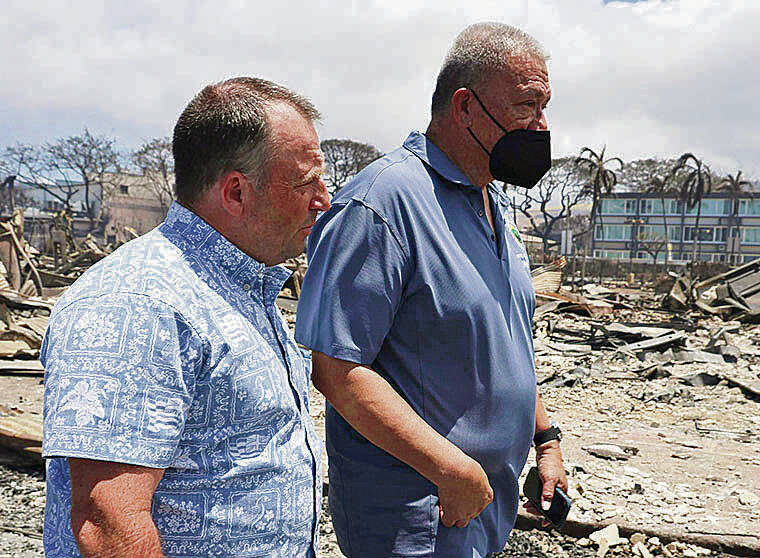Maui Strong Fund tops $190 million

MAUI COUNTY VIA ASSOCIATED PRESS / AUG. 10
Hawaii Gov. Josh Green, left, and Maui Mayor Richard Bissen walk past the burned remains along Front Street in Lahaina.
The Hawaii Community Foundation on Thursday said its Maui Strong Fund has raised over $190 million from 250,000 donors across 76 countries — distributing almost $90 million to provide immediate and long-term support to Maui wildfire recovery efforts.
HCF launched the Maui Strong Fund on Aug. 8, and CEO and President Micah Kane gave an update on it at a webinar in its “Eo” series, which focuses on providing access to community experts and leaders and hosting discussions on various local issues.
Since the fires, which killed at least 101 people and destroyed the heart of Lahaina, HCF has distributed almost $90 million across various sectors — including $51.7 million for lodging and shelter, $16.7 million in direct financial assistance and $4.4 million to fund health care, Kane said.
“Hawaii Community Foundation is committed for the long run to the people of Maui even beyond this disaster,” Kane said. “We’re so proud of the work that we’ve done together, and while we’ve made tremendous progress, we have a lot in front of us.”
Gov. Josh Green and Maui County Mayor Richard Bissen participated in the webinar, providing updates on recovery efforts and emphasizing the importance of rebuilding the Lahaina community.
Green began the discussion of recovery updates, citing housing as the “single largest challenge we have.” The wildfires destroyed or damaged at least 3,000 properties.
Don't miss out on what's happening!
Stay in touch with breaking news, as it happens, conveniently in your email inbox. It's FREE!
Green said the resources provided by HCF, combined with other state and federal resources, is aiding survivors in finding housing. The Council for Native Hawaiian Advancement’s Host Housing Support Program, in partnership with Maui County, has put hundreds of people into homes, Green said, and the state and county plan to build 1,044 new units of transitional housing.
“We’re pressing very hard on housing for the moment now, and also, we’re looking out a year and two years when we just won’t have the same kind of federal support, and we don’t want to fall off a cliff,” Green said. “We’re trying to be very proactive.”
Bissen said that as of Wednesday, 2,287 people were still being housed in 10 emergency hotel housing sites – down from almost 8,000 people in around 46 hotels at its peak. Debris cleanup has been completed in over 600, or approximately half, of the residential properties that were destroyed, and those properties are moving toward permitting for rebuilding. The county is working on assessing its wastewater infrastructure system, which is necessary before owners can begin returning to their properties.
Green said accelerating access to housing “had to be the priority” following the wildfires, but also in seeing locals move away from the islands due to unaffordable housing and many homes occupied solely for tourism.
“In many ways, housing is people’s well-being in this circumstance,” Green said. “Rebuilding the community, probably two years faster, maybe more based on the amount of work and moneys that are coming in from HCF, it will help a lot of people save and salvage their community.”
Since the wildfires, Green said, over 70% of people have been returned to long-term housing. As recovery efforts continue, Green said that in the next two years he wants to see 2,000 transitional houses built and another 2,000 permanent houses in construction, as well as clinics being rebuilt and “large pieces of land” restored to the Lahaina community. But beyond measurable goals, Green said rebuilding trust is also necessary.
“There’s been a great deal of loss of trust historically, not just Hawaii, in government and in communities where people feel left behind. I think that has to be reversed completely,” he said. “We have to have these palpable results for the community, and I honestly think that we have to listen and be informed by what their greatest concerns were before the fire and act on them.”
Lahaina community leader and waterman Archie Kalepa said the community is not only rebuilding itself through its infrastructure and buildings, but also with each other.
“At one point this community was fractured, but this community is in a place of rebuilding not only its place, but ourselves,” Kalepa said. “We’ve allowed ourselves to come even closer together and to begin to have ideas and discussions about how we rebuild our community. I think (that) has been really, really important to how we move forward.”
Green also addressed questions on the historical significance and potential restoration of Mokuula, a sacred island in Malu‘ulu o Lele Park in Lahaina that was buried over a century ago. As recovery efforts in Lahaina are underway, dialogue surround- ing restoring the cultural landmark has also begun.
“Restoring this area, which is extraordinary, which was driven by the natural waters, it’s more than just a practical, important thing to put back,” Green said. “It is actually symbolic of the way Hawaii survived and thrived for generations, and so, doing that will have a very outsized positive value for people who are coming back to their sense of Hawaii.”
As wildfire recovery efforts continue, Bissen said that he plans on measuring success on “whether or not we get the original Lahaina residents back to their homes.”
“It’s not just putting up a building or putting up a park or restoring power. It’s about restoring the heart of the community,” Bissen said. “What we really want, what we’re shooting for, is to have those folks that were (in Lahaina) before, return — return back to Maui if they moved off-island, return to Lahaina if they moved out of Lahaina. That’s really what we’re looking to do, and that’s what we’re hoping to measure success by.”



